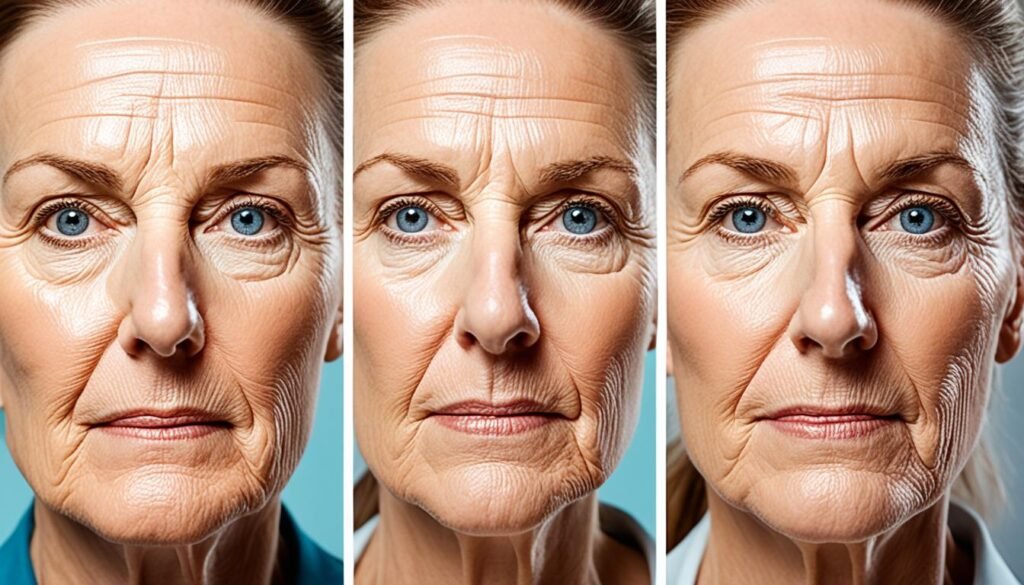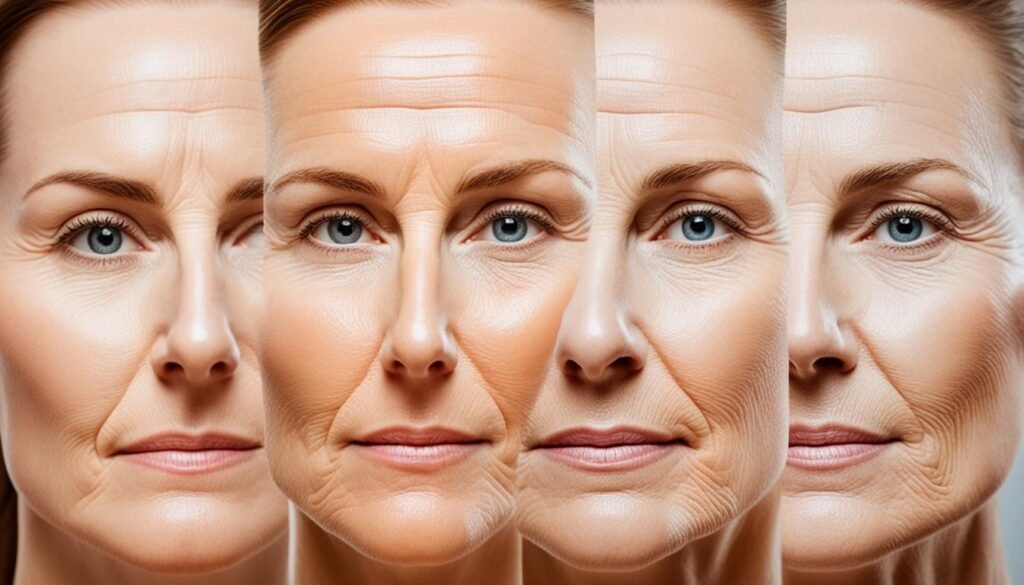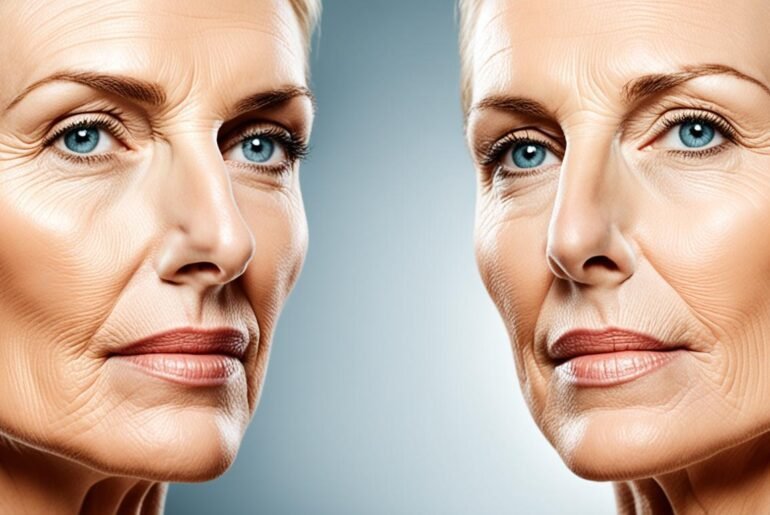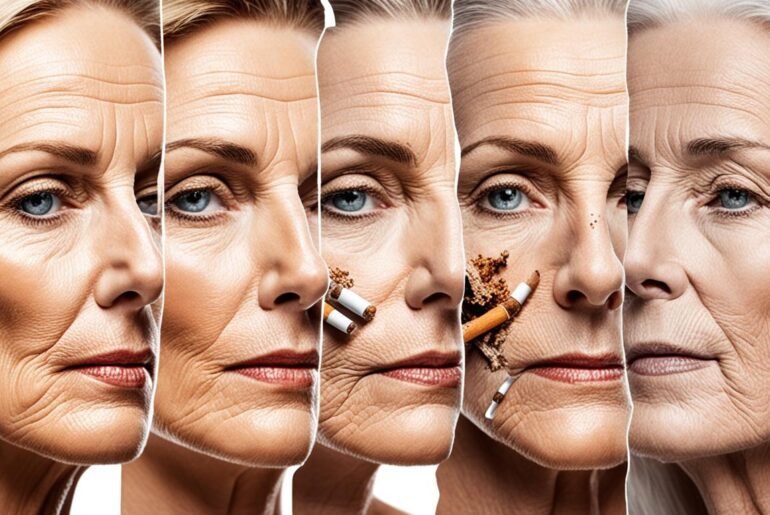Did you know that smoking exposes the skin to over 4,000 harsh chemicals? These chemicals not only lead to long-term skin disorders but also accelerate the aging process, causing premature wrinkles, sagging skin, and a dull complexion. However, there is good news. Quitting smoking can have a transformative effect on your skin, allowing it to repair, rejuvenate, and regain its vitality.
Key Takeaways:
- Smoking exposes the skin to harmful chemicals, leading to skin disorders and premature aging.
- Quitting smoking allows the skin to repair itself and regain its vitality.
- After quitting smoking, the skin experiences improved blood flow, oxygenation, and increased skin cell turnover.
- The positive effects of quitting smoking on the skin can be seen within weeks or months.
- Quitting smoking brings a range of benefits to the skin, including improved complexion and reduced signs of aging.
How Smoking Affects the Skin
Smoking has significant detrimental effects on the skin, exposing it to harmful toxins that hinder the absorption of essential oxygen, vitamins, and nutrients. These toxins can negatively impact every organ in the body, including the skin, leading to a range of skin issues and potential long-term damage.
One of the immediate effects of smoking on the skin is dryness. Smoking depletes the skin’s moisture and can leave it looking dull, rough, and aged. This can further result in the development of fine lines, wrinkles, and sagging, stripping the skin of its youthful appearance and elasticity.
Furthermore, smoking reduces the skin’s ability to retain a healthy color, often resulting in a pale or yellowish complexion. The impairment of blood flow caused by smoking can constrict the tiny blood vessels in the skin, hindering the delivery of oxygen and essential nutrients. This deficiency can deprive the skin of the necessary resources for proper cell regeneration and repair, leading to a lackluster and unhealthy appearance.
Moreover, smoking increases the risk of skin cancer. The harmful chemicals present in cigarette smoke can damage the DNA of skin cells and disrupt the skin’s protective barrier, making it more vulnerable to harmful UV rays and potentially leading to the development of skin cancer.
Quitting smoking is the most effective way to minimize the skin damage caused by smoking.
Smoking also contributes to the formation of wrinkles through repetitive facial movements such as pursing the lips while smoking. These repeated actions, combined with the reduced collagen and elastin production caused by smoking, can result in the premature onset of wrinkles and fine lines.
It is essential to highlight that the impacts of smoking on the skin are not irreversible. The sooner one quits smoking, the greater the potential for skin repair and restoration. Quitting smoking allows the skin to embark on a healing process, enabling it to rejuvenate and regain its vitality.
| Effects of Smoking on the Skin | Explanation |
|---|---|
| Dryness and rough skin texture | Smoking depletes the skin’s moisture, leading to dryness and a rough texture. |
| Wrinkles, fine lines, and sagging | Smoking reduces collagen and elastin production, resulting in premature aging signs. |
| Loss of healthy color | Smoking impairs blood flow and limits the delivery of oxygen and nutrients to the skin, causing a pale or yellowish complexion. |
| Increased risk of skin cancer | Smoking damages the DNA of skin cells, making them susceptible to the harmful effects of UV radiation and potentially leading to the development of skin cancer. |
By quitting smoking, individuals can take the first step towards reversing the skin damage caused by smoking and preventing further harm. Stay tuned for the following sections where we will explore the process of skin repair after quitting smoking and the timeline of skin recovery.
Skin Repair After Quitting Smoking

After quitting smoking, I experienced a remarkable transformation in my skin. The effects of quitting smoking on the skin are truly astounding. The changes I observed were not only physical but also a reflection of my improved overall health and well-being.
One of the first notable changes I noticed was an increase in skin cell turnover. As the toxins from smoking were eliminated from my body, my skin began to shed its dull and damaged cells and replace them with fresh, vibrant ones. This process helped to restore the natural radiance and youthful appearance of my complexion.
Another remarkable benefit of quitting smoking was the slowing down of the aging process. Smoking had accelerated the breakdown of collagen in my skin, leading to premature wrinkles and sagging. However, after quitting smoking, my body’s collagen production increased, resulting in firmer, more resilient skin.
A significant improvement I experienced after quitting smoking was the return of healthy color to my complexion. Smoking had disrupted the flow of blood and oxygen to my skin, causing it to appear pale and lackluster. But as I stopped smoking, my blood circulation improved, bringing a natural flush of color to my cheeks and a vibrant glow to my entire face.
Furthermore, quitting smoking not only helped repair the damage already done but also prevented further harm to my skin. Smoking had made my skin more susceptible to wrinkles, and the repetitive facial movements associated with smoking, such as pursing the lips and squinting the eyes, had created deep lines. But as I quit smoking, the progression of these wrinkles slowed down, making them more treatable and less noticeable.
The speed at which these positive effects occurred varied from person to person. Some people may see improvements in their skin within weeks of quitting, while for others, it may take months. Regardless of the timeframe, the bounce back of the skin after quitting smoking is remarkable and worth the wait.
Seeing the improvement in my own skin after quitting smoking inspired me to continue taking care of my skin and embracing a healthier lifestyle. It also made me more aware of the impact that smoking had on my skin health and reinforced the importance of quitting smoking for overall well-being.
| Beneficial Effects of Quitting Smoking on the Skin | Timeline |
|---|---|
| Skin cell turnover increases, promoting the production of healthy skin cells | Within weeks |
| The aging process slows down as collagen production increases | Within months |
| Improved blood flow brings back healthy color to the complexion | Within weeks |
| Prevents further damage and makes wrinkles more treatable | Within months |
The positive changes in the skin after quitting smoking are truly remarkable. It’s never too late to start the journey towards healthier skin. By quitting smoking, you’ll not only experience improvements in your skin but also reap countless other health benefits. Take the first step towards healthier, more rejuvenated skin by quitting smoking today.
Timeline of Skin Recovery After Quitting Smoking
The recovery of the skin after quitting smoking varies from person to person. However, there is a general timeline that can be observed, showcasing the improvements in skin health and appearance over time.
Within 2-3 days of quitting smoking, the skin starts to show signs of recovery. The color begins to return, and overall tone starts to improve. This is because quitting smoking allows for better blood circulation, leading to increased oxygenation of the skin cells.
After approximately 1 week of being smoke-free, the complexion starts to look more vibrant. The increased levels of oxygen and antioxidants in the body give the skin a healthy glow, making it appear more refreshed and revitalized.
By the 1-month mark, noticeable improvements in the skin’s health can typically be seen. As blood circulation continues to improve, there is enhanced skin cell turnover. This results in a smoother texture, a reduction in fine lines and wrinkles, and a more youthful appearance.
After 6 months of quitting smoking, the skin undergoes significant transformations. With a supportive lifestyle and proper skincare routine, you can expect to see further reductions in fine lines, wrinkles, and dark spots. The skin begins to regain its elasticity, resulting in a firmer and more toned complexion. Overall, the skin starts to look healthier and younger.
Within 1 year of quitting smoking, most of the skin’s recovery is typically complete. Former smokers often look years younger than their counterparts who continue to smoke. The skin has the ability to restore its natural vitality when freed from the harmful chemicals and toxins present in cigarettes.
| Time Period | Skin Recovery |
|---|---|
| 2-3 days | Improved skin color and tone |
| 1 week | Increased vibrancy and glow |
| 1 month | Enhanced skin cell turnover and healthy glow |
| 6 months | Reduction in fine lines, wrinkles, and dark spots |
| 1 year | Significant improvement in overall skin health |
It’s important to note that individual results may vary, and the timeline for skin recovery may differ depending on factors such as age, overall health, and skincare routine. However, by quitting smoking and adopting a healthy lifestyle, you are providing your skin with the best opportunity to recover and rejuvenate itself.
The Impact of Smoking on Skin Health
Smoking has a profound impact on skin health, causing a range of detrimental effects on the complexion. The habit narrows blood vessels, leading to reduced oxygen and nutrient supply to the skin. Additionally, smoking inhibits the production of collagen and elastin, crucial proteins responsible for maintaining skin elasticity and firmness.
These harmful effects result in several visible signs of skin damage, including prominent lines, wrinkles around the mouth, crow’s feet, sagging skin, age spots, and a pale complexion. Moreover, smoking can exacerbate pre-existing skin conditions such as psoriasis and acne, making them more difficult to manage and treat.
“Smoking accelerates the aging process and contributes to premature skin aging.”
Quitting smoking plays a crucial role in mitigating these adverse effects. By quitting, individuals can slow down the aging process, increase skin cell turnover, and restore collagen production. This, in turn, helps to reduce the appearance of wrinkles, restore skin elasticity, and promote a more youthful and vibrant complexion. Furthermore, quitting smoking prevents further damage to the skin, allowing it to heal and rejuvenate naturally.
It’s important to note that while some damage caused by smoking may be permanent, the skin possesses a remarkable ability to repair itself when given the chance. By quitting smoking and adopting a comprehensive skincare routine, individuals can proactively improve their skin health and overall appearance.
References:
- Department of Health and Human Services. (2014). The Health Consequences of Smoking—50 Years of Progress: A Report of the Surgeon General. Atlanta: U.S. Department of Health and Human Services, Centers for Disease Control and Prevention, National Center for Chronic Disease Prevention and Health Promotion, Office on Smoking and Health.
- Mukherjee, S., Date, A., Patravale, V., Korting, H. C., Roeder, A., & Weindl, G. (2006). Retinoids in the treatment of skin aging: an overview of clinical efficacy and safety. Clinical Interventions in Aging, 1(4), 327–348.
Benefits of Quitting Smoking for the Skin

Quitting smoking brings several benefits to the skin. When you quit smoking, you give your skin the chance to recover and improve in various ways:
- Slows down the aging process: Smoking accelerates the aging process, causing premature wrinkles, fine lines, and sagging skin. By quitting smoking, you can slow down the development of these signs of aging and maintain a more youthful appearance.
- Improves complexion and pigmentation: Smoking can leave the skin dull, sallow, and discolored. However, when you quit smoking, blood flow and oxygenation improve, leading to a brighter and more even complexion.
- Increases skin cell turnover: Smoking slows down the skin’s natural cell turnover process, resulting in a buildup of dead skin cells and a dull complexion. Quitting smoking allows for the renewal of skin cells, giving you fresher and healthier-looking skin.
- Reduces discoloration and staining: Smoking can cause dark spots, stains, and a yellowish tint to the skin. By quitting smoking, you can reduce these discolorations and restore a more vibrant and natural skin tone.
Moreover, quitting smoking not only benefits the appearance of your skin but also helps prevent the development of severe skin conditions. Smoking is known to increase the risk of skin cancer, psoriasis, acne inversa, vasculitis, and telangiectasia. By quitting smoking, you give your skin a chance to heal and reduce the chances of developing these serious conditions.
Overall, quitting smoking brings about significant improvements to the health and appearance of your skin. Embrace the decision to quit smoking and enjoy the rejuvenating benefits it brings to your skin.
How Quickly Can the Skin Recover After Quitting Smoking
The speed at which the skin recovers after quitting smoking varies for each individual. However, within a matter of days, improvements in skin color and overall tone can be observed. The elimination of smoking allows the skin to receive more oxygen and nutrients, leading to a revitalized complexion.
Within a week of quitting smoking, the body experiences increased blood flow and antioxidant levels. This boost in circulation contributes to a vibrant appearance and helps in healing the skin.
After a month of being smoke-free, better circulation continues to restore nutrients and oxygen to the skin, promoting healthy skin cell turnover. As a result, the complexion appears more youthful and radiant.
By the six-month mark, individuals often notice reductions in fine lines, wrinkles, and dark spots. The consistent improvement in the skin’s overall texture and appearance is a testament to the body’s remarkable ability to heal and regenerate.
After one year of being smoke-free, the skin’s recovery to its pre-smoking state is often complete. Former smokers commonly report that their skin looks and feels healthier, with a noticeable improvement in overall tone and elasticity.
It’s important to remember that everyone’s skin is unique, and individual results may vary. Factors such as lifestyle, genetics, age, and skincare routine can influence the speed and extent of skin recovery after quitting smoking.
Quitting smoking not only benefits the overall health but also plays a crucial role in restoring and rejuvenating the skin. By embracing a smoke-free lifestyle, individuals can experience remarkable improvements in their skin’s health and appear more vibrant and youthful.
| Timeframe | Skin Improvement |
|---|---|
| Within days | Improved skin color and overall tone |
| Within a week | Increased circulation and vibrant complexion |
| Within a month | Promotion of healthy skin cell turnover |
| Within six months | Reductions in fine lines, wrinkles, and dark spots |
| Within one year | Nearly complete recovery to pre-smoking state |
Tips for Restoring the Skin After Quitting Smoking

In addition to quitting smoking, there are several steps individuals can take to restore their skin after quitting. By incorporating these post-smoking skincare tips into a regular skincare routine, one can improve the condition and appearance of their skin.
- Maintain a balanced diet: A well-rounded diet that includes essential vitamins and nutrients can promote skin health and restoration. Incorporate foods rich in antioxidants, such as fruits, vegetables, and whole grains, to fight against skin damage caused by smoking.
- Exercise regularly: Regular physical activity improves blood circulation, which enhances the delivery of oxygen and nutrients to the skin. Engaging in activities like jogging, yoga, or swimming can help improve skin composition and overall health.
- Ensure enough sleep: A good night’s sleep allows the skin to repair and regenerate. Aim for 7-8 hours of quality sleep each night, as this is when the body goes into repair mode and aids in achieving optimal skin restoration.
- Protect against photodamage: Sunscreen is essential in preventing further damage to the skin. Apply a broad-spectrum sunscreen with an SPF of at least 30 daily, even on cloudy days, to shield the skin from harmful UV rays.
- Follow a regular skincare routine: Develop a skincare routine that includes cleansing, exfoliating, moisturizing, and applying targeted treatments. Choose products that are specifically formulated to restore the skin’s health and address post-smoking concerns.
- Consider in-office dermatology and beauty treatments: Professional treatments like chemical peels, microdermabrasion, and laser therapy can help improve skin texture, reduce discoloration, and enhance overall skin appearance. Consult with a dermatologist to determine the most suitable treatment options.
Incorporating these tips into a skincare routine can support the restoration of the skin after quitting smoking. By providing the necessary nutrients, protection, and targeted treatments, individuals can help their skin recover and regain its natural vitality and radiance.
Conclusion
Quitting smoking is not only a wise decision for overall health but also holds numerous benefits for the skin. By choosing to quit smoking, individuals can witness a remarkable transformation in their complexion. Improved complexion, diminished signs of aging, restored collagen production, and prevention of further damage are just a few of the positive changes that can occur.
While it is true that some of the damage caused by smoking may be irreversible, the skin possesses an extraordinary ability to repair and rejuvenate itself. By quitting smoking and adopting a consistent and healthy skincare routine, individuals can unlock the natural pathways to restore their complexion’s vitality.
It is important to note that patience is key in this process, as the speed at which the skin recovers varies among individuals. However, by quitting smoking, one takes the first and most vital step towards revitalizing their skin. Combining this with a well-balanced diet, regular exercise, sufficient sleep, adequate sun protection, a tailored skincare regimen, and potential in-office dermatological treatments, individuals can maximize their skin’s recovery and optimize the restoration process.
Quitting smoking is the start of a journey towards healthier skin and a renewed sense of confidence. By making this positive change, individuals can not only rejuvenate their skin but also vastly improve their overall well-being. The decision to quit smoking is undoubtedly a powerful step towards a brighter and healthier future.
FAQ
What are the effects of smoking on the skin?
Smoking exposes the skin to over 4,000 harsh chemicals, leading to long-term skin disorders and premature aging symptoms. It can cause loss of color, dryness, sagging, lines, wrinkles, warts, age spots, and even skin cancer.
How does the skin repair itself after quitting smoking?
After quitting smoking, the skin undergoes positive changes such as increased skin cell turnover, improved blood flow, and a slower aging process. The body’s supply of collagen increases, and healthy color returns to the complexion. Wrinkles become more treatable.
How long does it take for the skin to recover after quitting smoking?
The speed at which the skin recovers varies, but improvements can be seen within weeks or months of quitting smoking. Within 2-3 days, skin color starts returning. After 1 week, the complexion appears more vibrant. By 6 months, reductions in fine lines, wrinkles, and dark spots are noticeable.
What are the benefits of quitting smoking for the skin?
Quitting smoking slows down the aging process, improves complexion and pigmentation, increases skin cell turnover, and reduces discoloration and staining. It also prevents the development of serious skin conditions like skin cancer, psoriasis, acne inversa, vasculitis, and telangiectasia.
How quickly can the skin recover after quitting smoking?
The skin’s recovery speed after quitting smoking varies, but improvements can be observed within days to weeks. Within a matter of days, skin color and tone start to improve. Within a week, increased oxygen and antioxidants give the complexion a vibrant appearance. By six months, reductions in fine lines, wrinkles, and dark spots may be visible.
What tips can help restore the skin after quitting smoking?
In addition to quitting smoking, individuals can restore their skin by maintaining a balanced diet, exercising regularly, getting enough sleep, using sunscreen, following a skincare routine, and using products formulated to restore the skin’s health. In-office dermatology and beauty treatments can also help improve skin texture and reduce discoloration.
What is the overall impact of smoking on skin health?
Smoking narrows blood vessels, reduces oxygen and nutrient supply, inhibits collagen and elastin production, and leads to various skin issues such as wrinkles, sagging skin, age spots, and a pale complexion. It can worsen pre-existing skin conditions like psoriasis and acne.
What can be done to improve skin health after quitting smoking?
Along with quitting smoking, individuals can improve skin health by maintaining a balanced diet, exercising, getting enough sleep, using sunscreen, following a skincare routine, using products formulated to restore the skin’s health, and considering in-office dermatology and beauty treatments.
What are the final thoughts on skin rejuvenation after quitting smoking?
Quitting smoking brings several benefits to the skin, including improved complexion, reduced signs of aging, restored collagen production, and prevention of further damage. Although some damage caused by smoking may be permanent, the skin has the ability to repair and rejuvenate itself. By quitting smoking and adopting a healthy skincare routine, individuals can unlock the natural ways to restore their complexion’s vitality.




